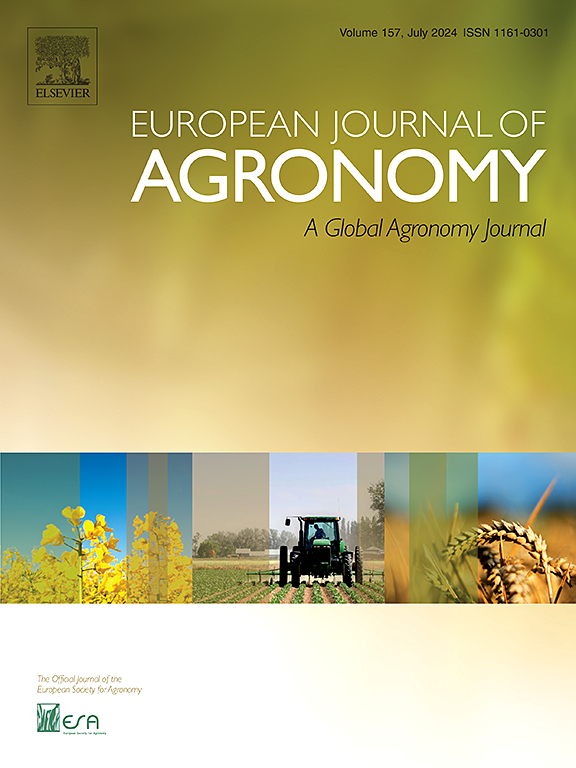基于无人机多光谱影像与激光雷达点云融合的玉米氮素利用效率估算方法
IF 4.5
1区 农林科学
Q1 AGRONOMY
引用次数: 0
摘要
氮素利用效率(NUE)是选择高效氮肥作物品种和优化施肥策略的重要指标。然而,NUE的评估通常使用破坏性和费力的抽样方法,阻碍了可持续农业的发展。目的是测试多源传感器同时获得的反映更多功能和结构性状的表型数据融合是否可以提高玉米高度整合性状NUE的估计精度。利用多传感器无人机平台,在两年的玉米品种和氮肥田间试验的关键生育期同时获取多光谱(MS)和光探测与测距(LiDAR)数据。选择偏最小二乘回归(PLSR)、随机森林回归(RFR)和支持向量机回归(SVR)三种机器学习算法,基于MS、LiDAR和MS+LiDAR三种数据源构建NUE估计模型。结果表明,不同玉米品种氮素利用效率(NUtE)和氮素农艺效率(NAE)在关键生育期存在显著差异。使用多源数据结合机器学习算法有效准确地识别这些差异。RFR方法模型验证精度最高,平均Rtest2 = 0.68,RMSEtest = 6.66 kg kg−1。与单一数据源相比,多源数据融合的平均精度提高了20.21 %,RFR+MS+LiDAR方法在Rtest2 = 0的2年验证数据集中获得了最高的模型精度。86和RMSEtest = 8.5 kg kg−1。本研究提出的方法减轻了玉米生长后期冠层光谱饱和的影响,通过改善预测值与实测值的收敛性,提高了NUE估算的精度。这种基于无人机平台的多源数据融合方法能够在关键的生长阶段有效地监测NUE。因此,它推进了玉米快速、无损的氮肥利用效率评估,支持高效育种和精确氮肥管理策略。本文章由计算机程序翻译,如有差异,请以英文原文为准。
Improved estimation of nitrogen use efficiency in maize from the fusion of UAV multispectral imagery and LiDAR point cloud
Nitrogen use efficiency (NUE) is a key indicator for selecting nitrogen-efficient crop cultivars and optimizing fertilization strategies. However, NUE is typically assessed using destructive and laborious sampling methods, hindering the advancement of sustainable agriculture. The objective is to test whether the fusion of phenotyping data simultaneously acquired by multi-source sensors that reflect more functional and structural traits can improve the estimation accuracy of the highly integrated trait NUE in maize. Multispectral (MS) and light detection and ranging (LiDAR) data were simultaneously acquired during critical growth stages across two years of maize cultivar and nitrogen fertilizer field experiments using a multi-sensor UAV platform. Three machine learning algorithms, Partial Least Squares Regression (PLSR), Random Forest Regression (RFR) and Support Vector Machine Regression (SVR) were selected to construct NUE estimation models based on three data sources:MS, LiDAR, and MS+LiDAR. The results demonstrated distinct differences in nitrogen utilization efficiency (NUtE) and nitrogen agronomy efficiency (NAE) among maize cultivars at critical growth stages. These differences were efficiently and accurately identified using multi-source data combined with the machine learning algorithms. The RFR method obtained the highest model validation accuracy with an average Rtest2 = 0.68 and RMSEtest = 6.66 kg kg−1. The average accuracy of multi-source data fusion was improved by 20.21 % compared to a single data source, and the RFR+MS+LiDAR method for NUtE estimation obtained the highest model accuracy in the two-year validation dataset with Rtest2 = 0. 86 and RMSEtest = 8.5 kg kg−1. The method proposed in this study mitigates the impact of canopy spectral saturation during the late growth stages of maize, enhancing the accuracy of NUE estimation by improving the convergence between predicted and observed values. This multi-source data fusion approach, based on a UAV platform, enables effective monitoring of NUE at critical growth stages. Consequently, it advances rapid, non-destructive NUE assessment in maize, supporting efficient breeding and precision nitrogen management strategies.
求助全文
通过发布文献求助,成功后即可免费获取论文全文。
去求助
来源期刊

European Journal of Agronomy
农林科学-农艺学
CiteScore
8.30
自引率
7.70%
发文量
187
审稿时长
4.5 months
期刊介绍:
The European Journal of Agronomy, the official journal of the European Society for Agronomy, publishes original research papers reporting experimental and theoretical contributions to field-based agronomy and crop science. The journal will consider research at the field level for agricultural, horticultural and tree crops, that uses comprehensive and explanatory approaches. The EJA covers the following topics:
crop physiology
crop production and management including irrigation, fertilization and soil management
agroclimatology and modelling
plant-soil relationships
crop quality and post-harvest physiology
farming and cropping systems
agroecosystems and the environment
crop-weed interactions and management
organic farming
horticultural crops
papers from the European Society for Agronomy bi-annual meetings
In determining the suitability of submitted articles for publication, particular scrutiny is placed on the degree of novelty and significance of the research and the extent to which it adds to existing knowledge in agronomy.
 求助内容:
求助内容: 应助结果提醒方式:
应助结果提醒方式:


